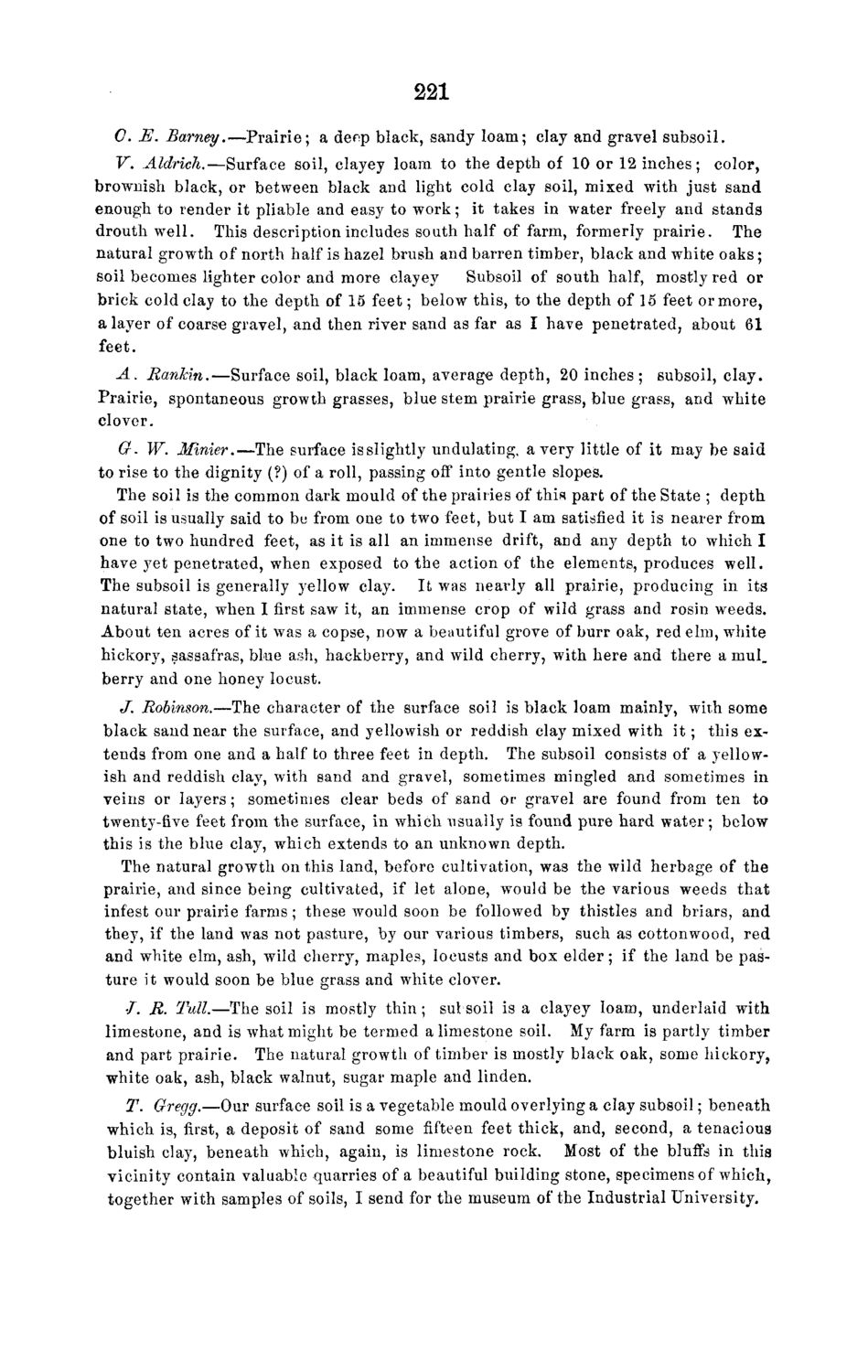| |
| |
Caption: Board of Trustees Minutes - 1868
This is a reduced-resolution page image for fast online browsing.

EXTRACTED TEXT FROM PAGE:
221 G. E. Barney.—Prairie; a deop black, sandy loam; clay and gravel subsoil. V. Aldrich.—Surface soil, clayey loam to the depth of 10 or 12 inches; color, brownish black, or between black and light cold clay soil, mixed with just sand enough to render it pliable and easy to work; it takes in water freely and stands drouth well. This description includes south half of farm, formerly prairie. The natural growth of north half is hazel brush and barren timber, black and white oaks; soil becomes lighter color and more clayey Subsoil of south half, mostly red or brick cold clay to the depth of 15 feet; below this, to the depth of 15 feet or more, a layer of coarse gravel, and then river sand as far as I have penetrated, about 61 feet. A. Rankin.—Surface soil, black loam, average depth, 20 inches; subsoil, clay. Prairie, spontaneous growth grasses, blue stem prairie grass, blue grass, and white clover. G. W. Minier.—The surface isslightly undulating, a very little of it may be said to rise to the dignity (?) of a roll, passing off into gentle slopes. The soil is the common dark mould of the prairies of this part of the State ; depth of soil is usually said to be from one to two feet, but I am satisfied it is nearer from one to two hundred feet, as it is all an immense drift, and any depth to which I have yet penetrated, when exposed to the action of the elements, produces well. The subsoil is generally yellow clay. It was nearly all prairie, producing in its natural state, when I first saw it, an immense crop of wild grass and rosin weeds. About ten acres of it was a copse, now a beautiful grove of burr oak, red elm, white hickory, sassafras, blue ash, hackberry, and wild cherry, with here and there a mul_ berry and one honey locust. J. Robinson.—The character of the surface soil is black loam mainly, with some black sand near the surface, and yellowish or reddish clay mixed with i t ; this extends from one and a half to three feet in depth. The subsoil consists of a yellowish and reddish clay, with sand and gravel, sometimes mingled and sometimes in veins or layers; sometimes clear beds of sand or gravel are found from ten to twenty-five feet from the surface, in which usually is found pure hard water; below this is the blue clay, which extends to an unknown depth. The natural growth on this land, before cultivation, was the wild herbage of the prairie, and since being cultivated, if let alone, would be the various weeds that infest our prairie farms; these would soon be followed by thistles and briars, and they, if the land was not pasture, by our various timbers, such as cottonwood, red and white elm, ash, wild cherry, maples, locusts and box elder; if the land be pasture it would soon be blue grass and white clover. / . R. Tall.—The soil is mostly thin; sulsoil is a clayey loam, underlaid with limestone, and is what might be termed a limestone soil. My farm is partly timber and part prairie. The natural growth of timber is mostly black oak, some hickory, white oak, ash, black walnut, sugar maple and linden. T. Gregg.—Our surface soil is a vegetable mould overlying a clay subsoil; beneath which is, first, a deposit of sand some fifteen feet thick, and, second, a tenacious bluish clay, beneath which, again, is limestone rock. Most of the bluffs in this vicinity contain valuable quarries of a beautiful building stone, specimens of which, together with samples of soils, I send for the museum of the Industrial University.
| |